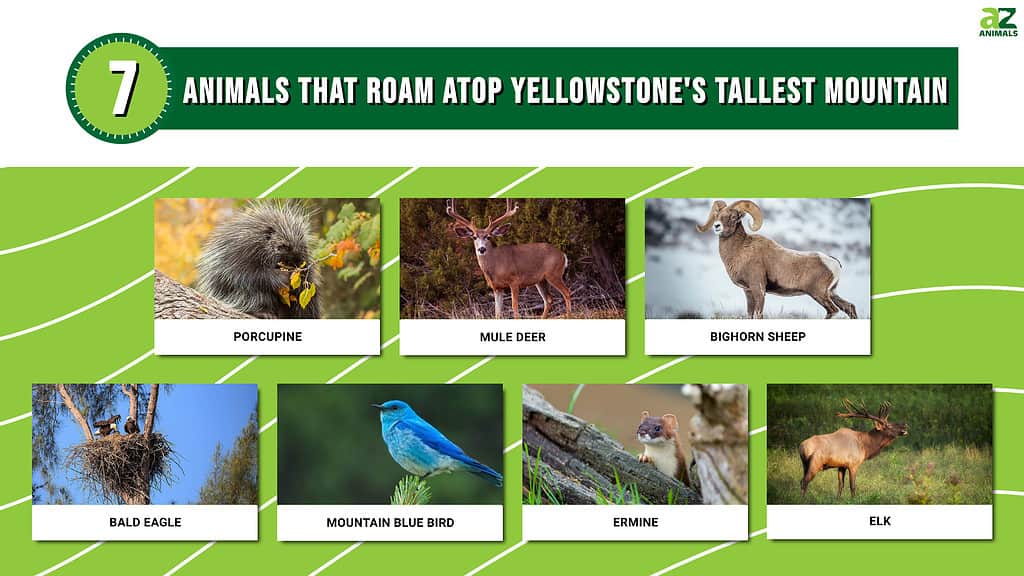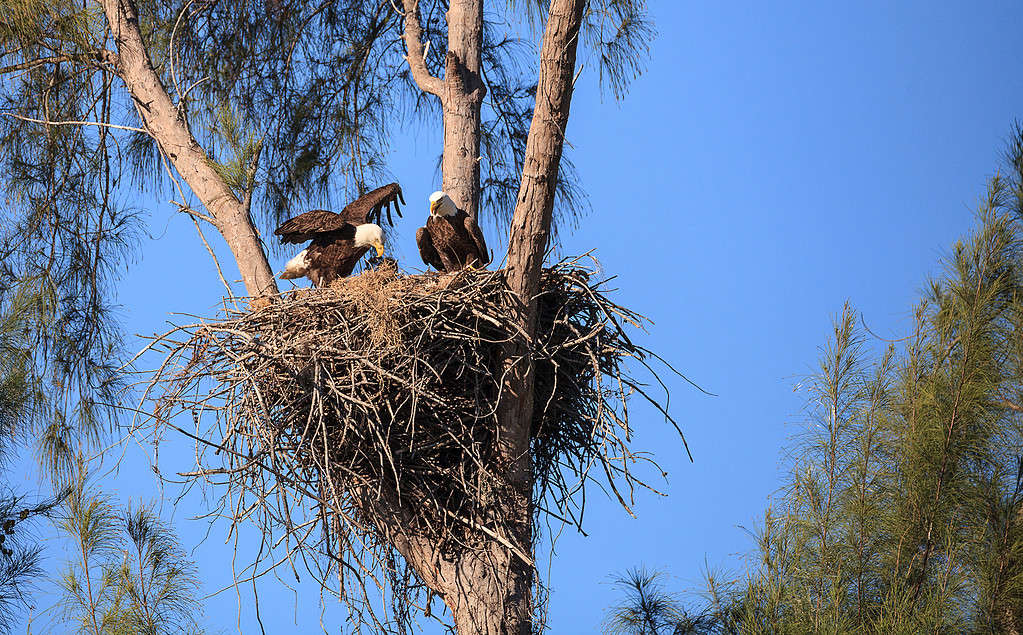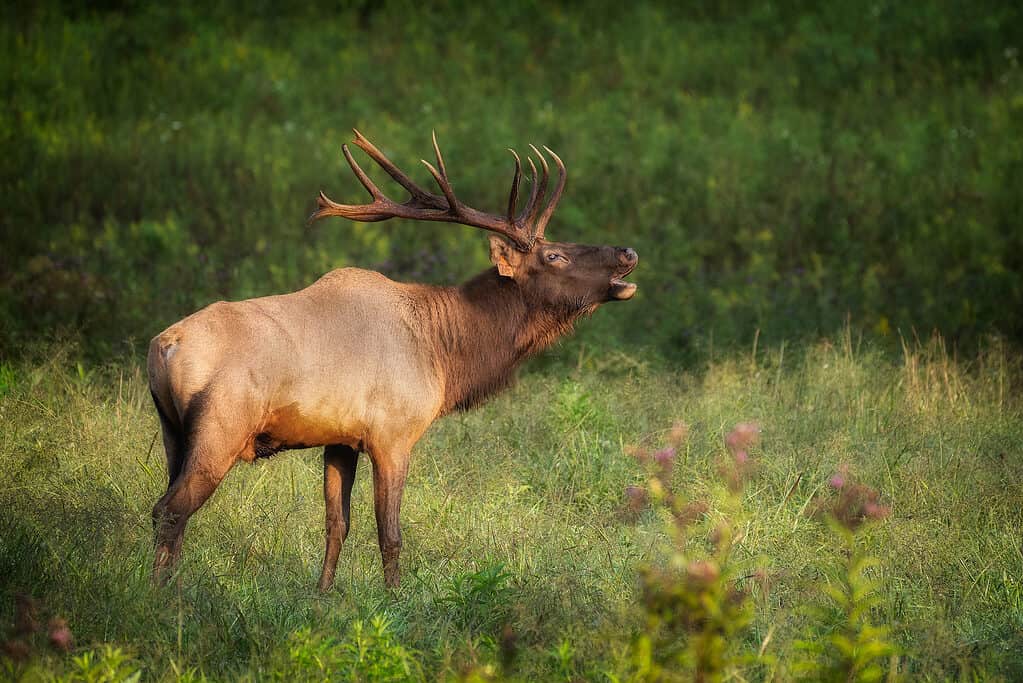Yellowstone National Park is home to a diverse range of wild animals, including those that roam atop its tallest mountain, Eagle Peak, Wyoming. Standing at an impressive 11,372 feet, this mountain range is located in the northeastern part of the park and offers stunning panoramic views for visitors who dare to trek to its summit.
Eagle Peak, Wyoming, is a part of the Absaroka Range, which extends from northern Wyoming into southern Montana. This rugged landscape provides a habitat for various wildlife species, such as bighorn sheep and mountain goats, that can be seen scaling cliffsides with ease. The area also boasts populations of elk and bears that are known to traverse through these high-altitude areas.

Eagle Peak is the highest point in Yellowstone National Park.
©Peter Kotoff/Shutterstock.com
Despite the harsh conditions found at higher elevations, many animals have adapted to thrive in this environment. For example, ermine can be spotted darting around rocks on sunny days gathering food for winter months when snow covers their rocky homes.
Visitors should exercise caution while exploring this area as it poses unique challenges due to unpredictable weather patterns and treacherous terrain. However, those who take on the challenge will be rewarded with breathtaking views and incredible encounters with some of Yellowstone’s most elusive creatures.
Animals That Roam Atop Yellowstone’s Tallest Mountain

Eagle Peak, located in Wyoming’s alpine tundra zone, is home to a diverse range of wild animals. However, the threat of climate change looms large over this ecosystem and has already started to impact the natural habitat of these creatures. As temperatures continue to rise, the fragile balance that sustains life on Eagle Peak is being disturbed.
The melting of glaciers and snowpacks is causing water levels in streams and rivers to fluctuate drastically, leading to an unstable environment for aquatic species such as trout and salmon. This also affects predators like bears, who rely on these fish for their survival. The reduction in food sources due to shifts in temperature patterns can lead to malnourishment or starvation among wildlife populations.
Additionally, changes in vegetation patterns are affecting herbivores such as elk and deer, who depend on specific plants for their diet. As some plant species thrive while others struggle with adverse weather conditions or invasive species encroachment, it can create uneven competition for resources that can lead to imbalances within animal populations.
Furthermore, increased wildfire activity caused by hotter temperatures threatens wildlife habitats by destroying forests and other vegetative cover essential for sheltering birds and mammals alike.
These challenges highlight how crucial it is that we take action against climate change before more damage occurs not only at Eagle Peak but across all ecosystems around the globe threatened by its effects.
1. Porcupine

North American porcupines are happy living in Yellowstone National Park.
©Warren Metcalf/Shutterstock.com
Porcupines are fascinating creatures that belong to the rodent family. They are known for their unique appearance, characterized by sharp quills or spines that cover their entire body. These quills serve as a defense mechanism against predators, and they can be raised when threatened to make the porcupine appear larger and more intimidating.
Porcupines primarily feed on tree bark, twigs, leaves, and other vegetation found in their habitat. They have strong teeth designed for gnawing through tough plant material. In addition to being herbivores, porcupines are also skilled climbers thanks to their sharp claws.
As for their habitat, porcupines can be found in various parts of North America, including Yellowstone’s tallest mountain peaks. They tend to prefer forested areas with plenty of trees for food and shelter. Porcupines build dens inside hollow trees or rock crevices, where they spend most of the day sleeping and resting.
Overall, while porcupines may not be the most glamorous animals out there – due mostly to those infamous quills – they play an important role in maintaining balance within ecosystems where they reside by helping control tree growth via selective pruning and providing a source of prey for larger carnivorous mammals such as cougars or wolves that hunt them from time-to-time!
2. Mule Deer

Mule deer live in several states in the US.
©iStock.com/Tiago_Fernandez
A species of deer that can be found in various parts of North America, including Yellowstone’s tallest mountain, is mule deer. They are named for their large ears, which resemble those of a mule. These herbivorous animals primarily feed on shrubs, grasses, and twigs. Their diet changes depending on the season as well as the availability of food in their habitat.
In terms of appearance, male mule deer have antlers that they shed annually, while females do not. The coloration of their fur varies from reddish-brown to grayish-brown, with white patches around their eyes and underbelly. They have long legs adapted for running and jumping over obstacles.
As far as habitat is concerned, mule deer can thrive in different environments ranging from deserts to forests. However, they prefer areas with mixed vegetation cover, such as sagebrush or oak brush habitats, where there is enough space to roam freely. In Yellowstone National Park specifically, these animals can be seen at higher elevations during summer months when the snow melts away, revealing plants that are vital to their survival.
Overall, Mule Deer are fascinating creatures that play an important role in our ecosystem by being both prey and predator simultaneously through life cycle stages, making them an integral part of wildlife conservation efforts across the United States.
3. Bighorn Sheep

Rocky Mountain sheep graze in the high mountains of Yellowstone.
©John Raptosh/Shutterstock.com
Bighorn sheep are a species of wild sheep that inhabit the mountainous regions of North America, including Yellowstone’s tallest mountain. They are named for their impressive horns, which can weigh up to 30 pounds and curl into a full circle in males. Females also have horns, but they are smaller in size.
The bighorn sheep is primarily herbivorous, feeding on grasses, shrubs, and succulent plants found at high elevations. Their digestive system is adapted to break down tough plant material efficiently. They also require water sources nearby as they do not obtain enough from their food.
Their appearance varies depending on age and gender. Males are larger than females weighing around 200-300 pounds, while females weigh between 100-200 pounds. Both sexes have light brown coats with white patches on their rumps and stomachs, along with dark patches on their faces.
Bighorn sheep prefer steep rocky terrains where they can escape predators such as wolves or cougars easily due to their agility skills. During winter months, when snow covers higher elevation areas where Bighorns reside, these animals will move towards lower elevations seeking food supplies below the snow line while using areas close by for shelter purposes until spring arrives again.
4. Bald Eagle

Bald eagles make their nests in Yellowstone National Park.
©iStock.com/LagunaticPhoto
The bald eagle is a majestic bird of prey that can be found in various parts of North America, including Yellowstone’s tallest mountain. These birds are easily recognizable with their distinct white head and tail feathers contrasting against their dark brown body. They possess sharp talons and a powerful hooked beak which they use to catch and eat fish, small mammals, and occasionally carrion.
Bald eagles typically prefer living near large bodies of water, such as lakes or rivers, where they can hunt for fish. However, they have also been known to inhabit areas with plenty of trees which provide them with ample opportunities to perch and nest.
Despite being one of the most iconic American animals, bald eagles were once on the brink of extinction due to habitat loss, hunting activities by humans, and pesticide usage. Thanks to conservation efforts led by government agencies such as the US Fish & Wildlife Service along with private organizations like The Nature Conservancy, populations have recovered significantly in recent years, allowing more people to witness these graceful creatures up close.
5. Mountain Blue Bird

Mountain bluebirds nest in dead trees.
©MTKhaled mahmud/Shutterstock.com
The mountain bluebird is a species of small, brightly-colored songbird that inhabits the high-altitude regions of Yellowstone’s tallest mountain peaks. These birds are primarily insectivores and feed on a variety of insects, such as beetles, grasshoppers, and spiders. Their bright blue feathers make them easily identifiable in their natural habitat, and they also have white underbellies and grayish-brown wings.
Their preferred habitat includes open woodland areas with dead trees or snags for nesting sites. They are known to form monogamous pairs during the breeding season, which typically begins in early May through July. The female will lay 4-6 eggs in her nest made from twigs, grasses, and pine needles.
Mountain bluebirds play an important role in the ecosystem by helping to control insect populations that can damage forest vegetation if left unchecked. However, like many other bird species worldwide, they face threats such as loss of habitat due to human activity and climate change.
Overall, the mountain bluebird is a fascinating animal deserving of recognition for its beauty and ecological importance within Yellowstone National Park’s unique ecosystem.
6. Ermine

Ermine are elusive and hard to spot.
©iStock.com/MikeLane45
Also known as stoats or short-tailed weasels, ermine are small carnivorous mammals that can be found in various habitats across North America, including Yellowstone National Park’s tallest mountain. These animals have a long and slender body with short legs and a bushy tail. They typically weigh between 2-6 ounces and measure around 7-13 inches in length.
These creatures have distinctive white fur during the winter months to blend in with the snow-covered landscape. However, their fur turns brown during warmer months to match their surroundings better. Ermines feed on small prey such as rodents, birds, fish, and insects. They are highly skilled hunters who use their sharp teeth and claws to catch their prey.
These animals prefer living in open grasslands or forests near water sources like rivers or streams where they can find food easily. Ermines make dens by digging burrows under rocks or logs or using abandoned burrows of other animals.
In summary, ermines are small carnivorous mammals found in various habitats across North America that have long and slender bodies with short legs and bushy tails. They change color according to seasons: white during winter months while brown during warmer ones; they primarily eat small prey like rodents; they live near water sources such as rivers or streams where they build dens for shelter which is usually underground beneath rocks/logs/abandoned burrows of other creatures.
7. Elk

A Rocky Mountain elk is an amazing sight to see.
©iStock.com/MattCuda
The Rocky Mountain Elk, also known as the wapiti, is a species of deer that is commonly found in North America. As one of the largest members of the deer family, these majestic animals can weigh up to 700 pounds and stand over five feet tall at their shoulders.
Rocky Mountain Elk are primarily herbivores and feed on a variety of plants, including grasses, shrubs, and even tree bark. Males typically have large antlers, which they use for defense against predators or to establish dominance in mating season. Female elk generally do not have antlers.
These magnificent creatures can be found in a range of habitats, including forests, meadows, and mountains across North America. In Yellowstone National Park specifically, they tend to congregate near rivers and streams where vegetation is abundant.
Despite being hunted extensively throughout history for their meat and hides, efforts towards conservation have allowed populations of Rocky Mountain Elk to recover significantly over recent years. Today these impressive animals continue to thrive throughout their natural ranges while captivating visitors with their beauty and grace.
Summary of 7 Animals That Roam Atop Yellowstone’s Tallest Mountain
| Animal | |
|---|---|
| 1 | Porcupine |
| 2 | Mule Deer |
| 3 | Bighorn Sheep |
| 4 | Bald Eagle |
| 5 | Mountain Bluebird |
| 6 | Ermine |
| 7 | Elk |
The photo featured at the top of this post is © John Raptosh/Shutterstock.com
Thank you for reading! Have some feedback for us? Contact the AZ Animals editorial team.






